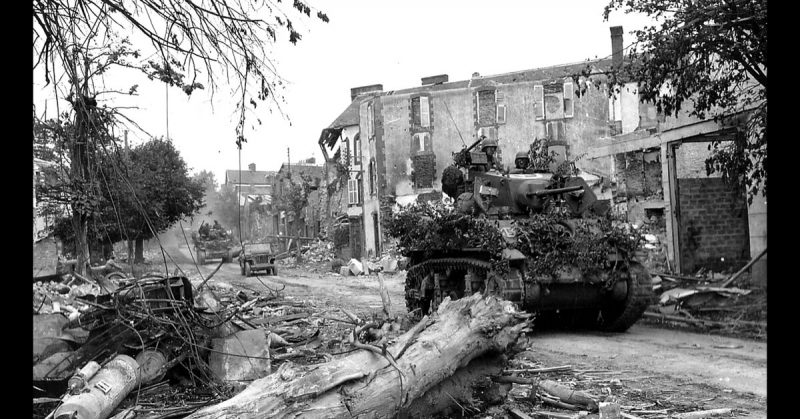In July 1944, Normandy was the scene of fierce fighting. Operation Neptune had seen the Allies land on the coast on June 6, D-Day. Following the largest seaborne invasion in history, they had started moving inland. The Germans were putting up a strong defense, preventing them from progressing through Normandy. A breakthrough was necessary. Operation Cobra began.
Normandy
Operation Overlord, the invasion of Normandy which included Neptune and Cobra, started well. Despite heavy losses on some beaches and the scattering of paratroopers across the French countryside, the Allies had gained a foothold in France. British advances around Caen stalled due to the German resistance, but progress was being made, albeit slowly.
While Normandy had provided favorable landing beaches, it was a tough country to advance through. The bocage dominated the region; terrain made up of woodland and pasture with sunken routes, winding roads, and dense hedgerows. It was excellent territory to defend. The Germans used it to ambush the advancing Allied forces.
Then came the rains. Throughout July, Normandy was drenched by torrential downpours. The mud and slow progress brought memories of the First World War. Something needed to be done to prevent a stalemate.
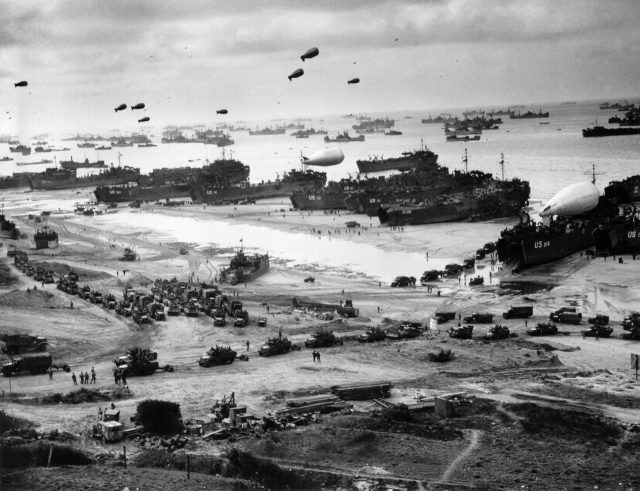
The Shadow of Patton
US General George S. Patton was a figure so powerful that, although not partaking in battle, he helped to shape the outcome.
A skilled and strong-minded tank commander, Patton was a hero to some among the Allies and a liability to others. He had been removed from command after slapping a shell-shocked soldier in an Italian hospital.
Patton’s public profile protected him from the worst consequences of his actions, as did his skills. He was a tool the Allies were loath to waste.
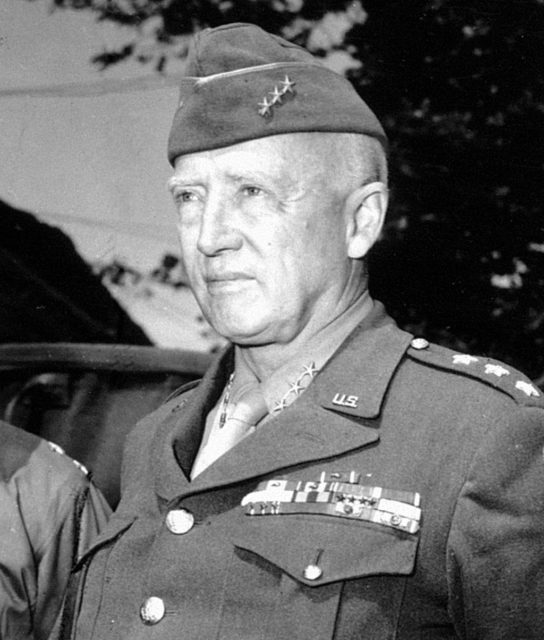
Without fighting, Patton had proved useful to the Normandy landings. The Germans were aware of his military skills and did not believe he would not be used. By putting him in charge of a non-existent First US Army Group, the Allies tricked Hitler who spent weeks waiting for an invasion around Calais by imaginary forces. German tank divisions were diverted to the area.
Now the time had come to bring Patton in.
Pinning Down the Germans
The way for Patton’s advance was paved in part by his greatest rival.
Patton had clashed with the British General Bernard Montgomery during their time together in Africa and Italy. Montgomery had been in overall command of ground forces during the D-Day landings and was now commanding British troops on the east flank of the Allied line. There, he was struggling to advance against stiff German opposition.
On July 18, Montgomery launched Operation Goodwood. Amid the intense fighting, the British finally took the town of Caen. In doing so, they diverted German armor away from the American sector. They also destroyed many of the tanks thrown against them.
Goodwood was extremely costly in lives and did not bring the triumph Montgomery had hoped for. However, it was appreciated by General Omar Bradley, the American commander. By drawing German attention, it had created an opportunity.
Cobra: Breaking Through
A month after the D-Day landings, Patton had arrived in Normandy. Hidden away behind Allied lines, he assembled the US Third Army, the force with which he would launch his attack.
Now Bradley was ready for his big move.
On July 25, Operation Cobra began. 3,000 American bombers flew over the German lines near St-Lô. Between them, they dropped 4,000 tons of napalm, high-explosives and fragmentation bombs. A five-mile stretch of German lines was devastated. The German commander estimated 70% of his men were put out of action; dead, wounded, or so traumatized they could no longer fight.
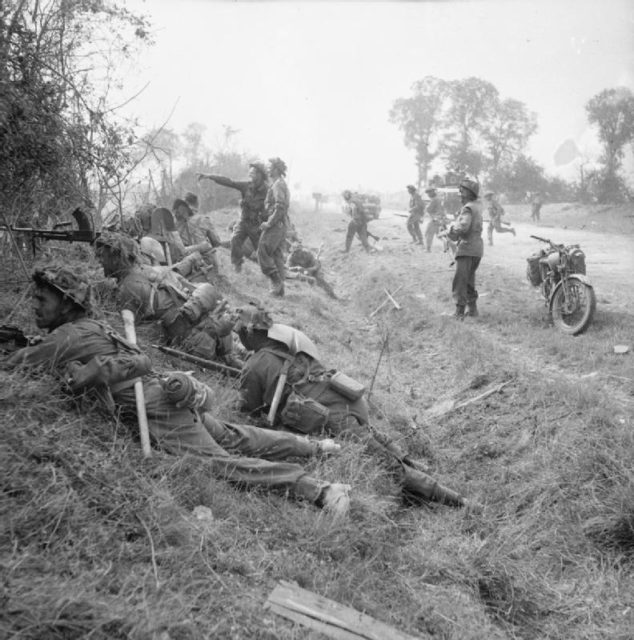
Now the advance began, led by the VII and VIII Corps of the US First Army.
The ground they advanced into was a smashed and charred landscape of craters. The German lines were fragmented but not destroyed. Groups of Germans held out, putting up stiff resistance. When forced to withdraw, they left behind booby traps and minefields. The distraction to the east meant they had not prepared a defense in depth, but they were skilled at improvising.
Progress picked up after the first day. The remaining German positions were whittled away. Under orders from Hitler not to retreat, the Germans kept fighting rather than beginning a tactical withdrawal.
Coutances was taken on July 27, Avranches on the 30th. The German line was collapsing.
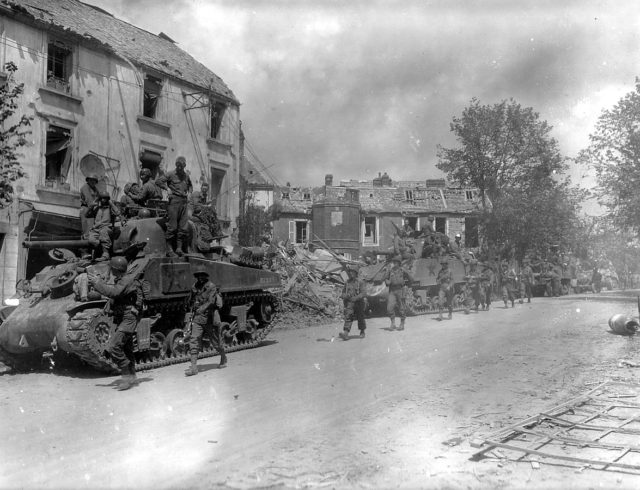
Patton’s Punch
Now came Patton’s moment to shine.
On July 30, the Third Army burst through the gap. Led by the 4th Armoured Division, they stormed west and south. They met and crushed opposition along the way. A small unit from 4th Armoured destroyed the HQ of an SS Panzer division.
The Germans had no idea where Patton was going or how to react. As he sped south, they had neither the resources nor the information to block him.
He quickly took most of Brittany and then sped east. On August 13, he reached Argentan, 15 miles south of Falaise. The entire German Seventh Army was close to being captured. Their only way out was the Falaise gap, but Hitler would not let them retreat. While Patton’s tanks drove east toward Paris, the Allies closed the gap. The Seventh Army was captured with 50,000 prisoners taken.
Cobra had been a huge success. France had been opened up. In a swift, sweeping move, Patton had seized the opportunity.
The Allies were out of Normandy.
Sources:
Nigel Cawthorne (2004), Turning the Tide: Decisive Battles of the Second World War.
David Rooney (1999), Military Mavericks: Extraordinary Men of Battle.
